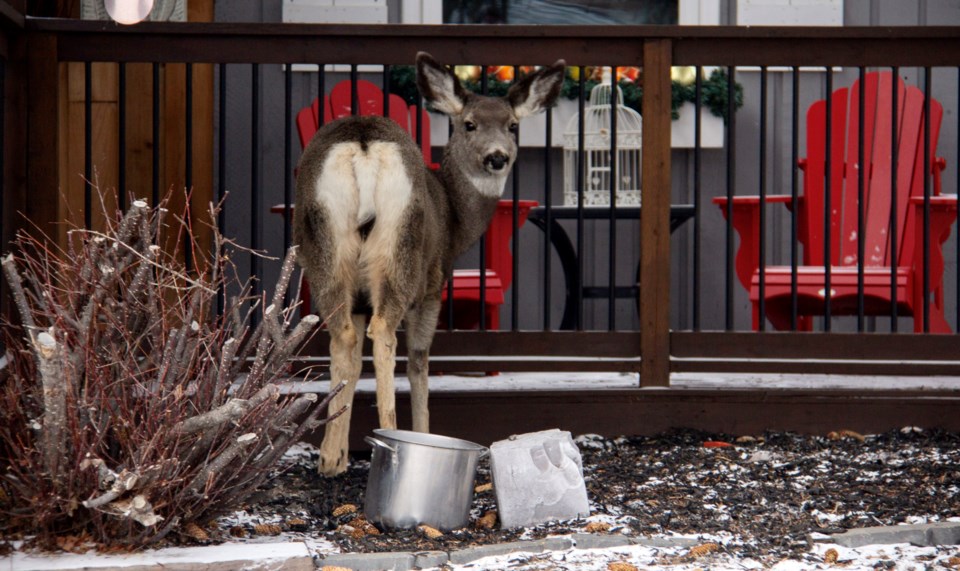Town of Okotoks staff and volunteers took part in the 2024 deer count Wednesday morning, conducted as part of the Town's response to growing concerns and demand for action on the urban deer population.
Since 2015, the Town has conducted regular counts to study the growing urban deer population. The first count in 2015 tallied 66 deer, a number which had increased to 108 by the 2020 count.
Last year's count showed that Okotoks' deer population had grown to 139, up from 124 a year earlier.
I was invited to take part in the deer count, not as a Western Wheel reporter but as a volunteer. As an avid wildlife photographer and nature enthusiast, I was happy to show up at 7 a.m. for onboarding before the 7:45 a.m. start to the count.
I was paired with Gordon White, the Town's urban forestry parks technician and chief organizer of the deer count. He drove a Town of Okotoks truck, and I was designated as a counter. Essentially, my task was to count deer and jot down data that I observed during the count while White drove us along a mapped-out route.
Volunteers paired up and drove around town on designated routes, counting deer as they went along. The count is far from scientific, White acknowledged, but it gets the job done.
As a counter, I wrote down the number, sex and species of deer observed, the location they were spotted and the time they were observed, all in an effort to avoid duplication.
Conducted from 7:45 to 8:45 a.m., White said the count is held at dawn every February for a multitude of reasons, primarily because deer are more active in the early morning and most bucks have yet to shed their antlers during the winter, allowing counters to more accurately determine sex.
We counted 24 deer along our route, the highest number counted by any pair that day and White's personal record.
They were all mule deer; whitetails are relatively uncommon in Okotoks and Diamond Valley, and are far more likely to be seen in Calgary and High River.
As I counted deer, I found myself more interested in something else I saw along the route than I was by the actual deer: countless plants had been ravaged. Trees had bark and branches stripped after bucks had scraped their antlers against them, junipers and other leafy plants were stripped bare and front lawns were being ravenously grazed by deer in front of houses.
White said damage to plants and subsequent costs are among the biggest concerns to both Town staff and residents.
One house that we drove by had a pot filled with food for deer, a blatant violation of a Town bylaw that strictly forbids the feeding of deer and other wild animals.
The feeder had attracted a deer to the house. White said that too many residents think of the deer as domestic animals they can feed and interact with as they please, and that actions like these only worsen the situation.
Feeding has been identified as one of the biggest reasons for the habituation of deer in urban environments like Okotoks. Coun. Rachel Swendseid expressed these concerns in a council meeting on Feb. 26.
"We can remove all the deer we want," she said, "but if people are going to feed them when they start re-establishing themselves, it doesn’t make any sense."
A few deer were also visibly injured, with at least one limping and another having what appeared to be a broken front leg. Injured deer in an urban setting are at much less risk of predation and have much easier access to food, making the town an ideal environment for them.
White said that due to the safety of the urban environment, deer are able to extend their mating seasons and have more offspring, with fawns a common sight in Okotoks.
White represents the Town of Okotoks on the Municipal Conflict Wildlife Collaborative formed by 10 southern Alberta municipalities to combat issues such as urban deer populations, which had their first meeting yesterday. He hopes the Town of Diamond Valley will consider conducting a deer count in light of its similarly-controversial deer situation.
Selling more deer hunting licences for the area surrounding Okotoks was one potential solution White proposed. He did not rule out a cull as a possibility, and said that Alberta Fish & Wildlife would likely approve a cull if a request was made.
After the count concluded at 8:45 a.m., we all reconvened to share what we found. Nobody had witnessed any blatant feeding of wildlife or interactions with humans, but the deer-feeding pot White and I discovered did raise significant concern.
White said results of the count will be shared in the coming weeks.




